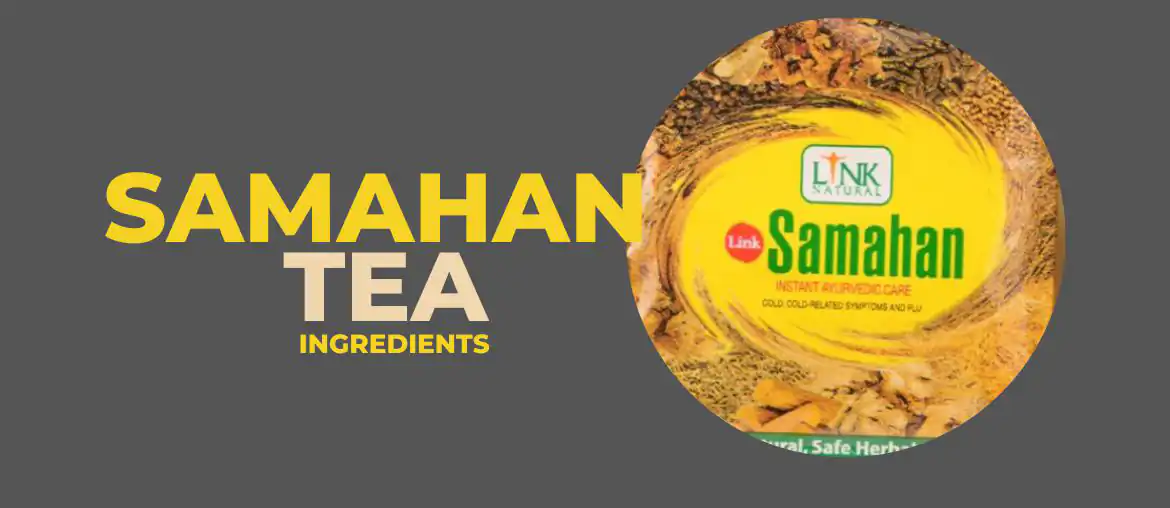Samahan tea contains a blend of 14 herbs and roots known for their ancient Ayurvedic and traditional use in relieving common health issues. The mix includes Adhatoda root, a common expectorant and decongestant, and Alpinia galanga rhizome, which provides anti-inflammatory effects. Coriander and cumin seeds provide digestive benefits and help with gas, bloating, and indigestion, while ginger rhizome is a carminative to reduce intestinal gas.
The star ingredient is the liquorice stem – Glycyrrhiza glabra – which helps soothe the stomach lining and fights infectious organisms. Several herbs in the mix, such as long pepper and yellow berried nightshade, carry antimicrobial properties that help support overall health. When brewed together, the herbal blend provides antioxidant and anti-inflammatory effects that may offer possible protection against chronic diseases.
The synergistic combination of these 14 traditional Ayurvedic herbs in Samahan tea offers a time-tested approach for promoting digestive health, improving liver function, and boosting the immune system.
What are the health benefits of the individual ingredients in Samahan tea?
Here is detailed information on 14 herbs and their uses that are contained in Samahan tea.

Malabar Nut (Adhatoda) – Root
Malabar nut, also known as adathoda or Adhatoda vasica, is a plant species commonly used in Ayurvedic and Siddha medicine. The root of the adathoda plant is used in Samahan herbal tea for its medicinal properties.
Adathoda root contains several phytochemicals, such as alkaloids, saponins, flavonoids, and tannins. The most important active constituents are vasica alkaloids that give adathoda its expectorant, antiasthmatic and anti-inflammatory effects.
Health Benefits and Uses of Adathoda Roots
- Expectorant
- Adathoda root contains vasaka alkaloids that help loosen excess mucus and phlegm in the respiratory tract. It helps treat cough, cold, sinusitis, and bronchitis.
- Antiasthmatic
- Vasaka alkaloids act as bronchodilators that help open up constricted airways. Adathoda root can provide relief from asthma symptoms.
- Anti-inflammatory
- Adathoda root has anti-inflammatory properties that can help reduce inflammation in the respiratory tract and elsewhere in the body.
- Antibacterial
- Studies show that adathoda root extract has antibacterial activity against certain strains of bacteria like E. coli and Staphylococcus aureus.
- Antitussive
- Adathoda root is sometimes used to suppress coughing by numbing the cough reflex and healing irritated mucous membranes.
Thus in Samahan herbal tea, adathoda root is an expectorant, reducing excess mucus and phlegm. It also offers some anti-inflammatory, antibacterial, and antitussive benefits.
Alpinia Galanga – Rhizome
Alpinia galanga, also known as Siamese ginger, greater galangal, or Java galangal, is a plant indigenous to Southeast Asia. This plant’s rhizome (underground stem) is used medicinally and included in Samahan herbal tea.
Alpinia galanga rhizome contains a range of medicinally active compounds, including alkaloids, phenolic compounds, and terpenes. In particular, it contains:
- Gingerols – Compounds that give galangal and ginger their spicy flavor and contribute to their medicinal effects. Gingerols have anti-inflammatory and analgesic properties.
- Shogaols – Hot and pungent compounds providing galangal analgesic and anti-inflammatory effects.
- Eucalyptol – A compound that provides galangal’s antibacterial and antifungal effects and contributes to its anti-inflammatory activity.
Health Benefits and Uses of Alpinia Galanga
Alpinia galanga rhizome is used in traditional Ayurvedic and Chinese medicine to:
- Relieve pain
- Analgesic and anesthetic properties help relieve pain, particularly in the digestive tract.
- Reduce inflammation
- Particularly useful for inflammatory bowel conditions and arthritis due to its potent anti-inflammatory compounds.
- Fight infections
- It exhibits antibacterial and antifungal effects that can help treat gut and urinary tract infections.
- Ease digestive issues
- It promotes digestion and secretion of digestive juices, helping to relieve gas, bloating, and diarrhea.
Thus in Samahan tea, Alpinia galanga rhizome serves as a carminative to ease digestion and as an anti-inflammatory and analgesic for the gut.
Ajwain – Rhizome
Ajwain rhizome comes from the Carum copticum (Trachyspermum ammi) plant, which is native to India and the Middle East. The root rhizome of the plant is utilized for its medicinal properties.
Ajwain rhizome contains various bioactive compounds, including:
- Thymol: An aromatic compound that gives Ajwain its distinctive flavor and contributes to its carminative, antiviral, and antioxidant effects.
- Cymene: A constituent that provides Ajwain’s antispasmodic, antimicrobial, and antioxidative properties.
- Calcium channel blockers: Compounds that help relax muscles and ease spasms.
Health Benefits and Uses of Ajwain Rhizome
- Carminative
- Ajwain helps reduce gas, bloating, and abdominal distension by stimulating digestive juices and enzymes.
- Antispasmodic
- Ajwain acts as a smooth muscle relaxant, easing intestinal spasms, colic, diarrhea, and abdominal cramping.
- Digestive aid
- Ajwain increases the secretion of gastric juices to improve appetite and digestion in general.
- Antimicrobial
- Ajwain essential oil has mild antibacterial, antifungal, and antiviral properties.
- Anthelmintic
- Ajwain may help expel parasites from the digestive system by paralyzing and killing them. However, human evidence is lacking.
So in Samahan tea, ajwain rhizome mainly functions as a carminative and antispasmodic for relieving gas, bloating, diarrhea, and abdominal pain.
The high concentration of thymol and cymene in ajwain contributes most significantly to its medicinal properties.
Coriander – Seed
Coriander seed comes from the Coriandrum sativum plant and contains numerous bioactive compounds contributing to its health benefits. These compounds include:
- Polyphenols – Like flavonoids and phenolic acids that act as antioxidants and may reduce inflammation.
- Monoterpenes – Including linalool and geraniol, helps relieve symptoms like gas, bloating, and indigestion.
- Minerals – Coriander seeds are high in minerals like potassium, calcium, and magnesium, which are important for digestive health.
- Fiber – Coriander seeds are a good source of insoluble and soluble fiber to promote healthy bowel function.
Health Benefits and Uses of Coriander Seed
- Antioxidant
- Coriander seeds are a good source of antioxidant polyphenols that can neutralize free radicals and reduce oxidative stress.
- Anti-inflammatory
- Compounds like flavonoids in coriander seeds have anti-inflammatory effects that may benefit digestive health.
- Antibacterial
- Early studies suggest coriander seed extract shows antimicrobial activity against some bacteria.
- Digestive aid
- Coriander seeds relieve symptoms like gas, bloating, and indigestion due to their carminative monoterpenes and fiber content.
- Cholesterol-lowering
- There is some evidence that coriander seeds may help reduce cholesterol levels and promote heart health.
In Samahan herbal tea, coriander seeds primarily function as a digestive aid and provide antioxidant and anti-inflammatory benefits.
False Calumba – Stem
False calumba, also known as Coscinium fenestratum, is a woody climbing vine native to Southeast Asia. The stem of the false calumba plant is used medicinally.
- False calumba stem contains various active compounds, including alkaloids, saponins, and tannins. The main types of alkaloids in false calumba are:
- Berberine: An alkaloid that has antibacterial, anti-inflammatory, and cholesterol-lowering effects.
- Palmatine: An alkaloid that has antioxidant, anti-inflammatory, and liver-protective properties.
- Jatrorrhizine: An alkaloid that can stimulate bile flow and aid digestion.
These alkaloids give false calumba stem its main therapeutic benefits.
Health Benefits and Uses of False Calumba Steam
- Digestive aid
- False calumba stem contains bitter alkaloids that can stimulate digestive juices and enhance appetite. It acts as a bitter tonic.
- Antimicrobial
- Berberine alkaloid in false calumba has mild antibacterial and antifungal effects.
- Antioxidant
- Compounds like palmatine alkaloids provide false calumba’s antioxidant and free radical scavenging activity.
- Hepatoprotective
- False calumba stem helps protect the liver from damage and supports its function, thanks to alkaloids like berberine and palmatine.
- Anti-inflammatory
- False calumba contains anti-inflammatory alkaloids that may help reduce inflammation in the digestive system and body.
In Samahan herbal tea, the false calumba stem likely functions as a digestive aid due to its bitter alkaloids. It may also provide some liver support and antioxidant benefits.
Cumin – Seed
Cumin seeds come from the Cuminum cyminum plant and contain several active constituents that give the seeds their multiple benefits.
- Thymol: An aromatic compound that gives cumin its distinct flavor and aroma. Thymol is carminative and antibacterial.
- Cuminaldehyde: A pungent organic compound that promotes the secretion of digestive juices and relieves flatulence.
- Fiber: Cumin seeds are high in soluble and insoluble fiber, supporting healthy digestion.
These components give cumin seeds their main therapeutic effects.
Health Benefits and Uses of Cumin Seeds
- Carminative
- Cumin seeds stimulate the secretion of digestive juices that aid in breaking down food and relieving gas. They often treat conditions like bloating, indigestion, and flatulence.
- Appetite stimulant
- Cumin seeds promote the secretion of gastric juices that stimulate appetite and aid nutrient absorption.
- Anti-inflammatory
- Cuminaldehyde and other compounds in cumin seeds have anti-inflammatory effects, especially in the digestive tract.
- Antibacterial
- Thymol and other constituents of cumin seeds have mild antibacterial activity against certain pathogenic bacteria.
- Antioxidant
- Cumin seeds contain polyphenols and flavonoids that act as antioxidants and help fight free radical damage.
In Samahan herbal tea, cumin seeds mainly serve as a carminative to ease digestive symptoms like gas, bloating, and colic. They also provide antioxidant and anti-inflammatory benefits.
Evolvulus Alsinoides – Whole Plant
Evolvulus alsinoides, also known as shankpushpi or dwarf morning glory, is a common creeping herb in India, Pakistan, and Sri Lanka. The entire aerial parts of the plant (leaves, stems, and flowers) are used medicinally.
The Evolvulus alsinoides plant contains several phytochemicals that contribute to its medicinal effects. These include:
- Flavonoids like orientin and vicenin have anti-inflammatory and antioxidant activity.
- Alkaloids like convoline and volkensifolin exhibit antispasmodic and sedative effects.
- Saponins have immune-boosting, anti-inflammatory, and antidiabetic properties.
- Tannins that act as astringents and support wound healing.
These constituents give the Evolvulus alsinoides plant its main therapeutic uses.
Health Benefits and Uses of Evolvulus Alsinoides
- Anti-inflammatory
- The flavonoids and saponins in the plant have anti-inflammatory effects that may benefit digestive health.
- Antispasmodic
- The alkaloids help relax smooth muscles and ease cramps, making them useful for relieving digestive spasms.
- Antioxidant
- The plant contains various antioxidants that can neutralize free radicals and help fight oxidative stress.
- Sedative
- The alkaloids in the plant have sedative properties that may provide a soothing effect.
- Antidiabetic
- Preliminary studies suggest the plant may help control blood sugar levels.
In Samahan herbal tea, the whole Evolvulus alsinoides plant likely provides digestive benefits due to its anti-inflammatory and antispasmodic effects. It may also offer antioxidant and sedative activity.
Liquorice – Stem
Liquorice stems come from the Glycyrrhiza glabra plant. Various parts of the liquorice plant have been used as a traditional herbal remedy for centuries.
Liquorice root contains two main bioactive compounds responsible for its medicinal effects:
- Glycyrrhizin – A sweet compound that gives liquorice its distinctive taste and provides many of its medicinal benefits.
- Flavonoids – Plant compounds that act as antioxidants and contribute to liquorice’s anti-inflammatory activity.
Health benefits and uses of Glycyrrhiza glabra
- Anti-inflammatory
- Glycyrrhizin and flavonoids in liquorice have anti-inflammatory properties useful for reducing cough, sore throat, and gastrointestinal inflammation.
- Antioxidant
- Liquorice contains various polyphenolic antioxidants that help fight free radical damage and oxidative stress.
- Antiviral
- Glycyrrhizin may help inhibit the replication of certain viruses, though the evidence is limited for its antiviral effects in humans.
- Demulcent
- Glycyrrhizin soothes and coats mucous membranes, soothing irritated tissues in the respiratory and digestive tracts.
- Expectorant
- Liquorice stem may help loosen mucus and phlegm in the respiratory tract, although it’s a mild expectorant.
In Samahan tea, liquorice stems likely provide anti-inflammatory and demulcent benefits to soothe the digestive tract. Its antiviral effects are yet to be confirmed. But liquorice is well known for relieving cough and soothing irritated throats due to its demulcent and anti-inflammatory compounds.
Hedyotis Herbacea – Whole Plant
Hedyotis Herbacea, also known as Oldenlandia diffusa or Rubiaceae, is a herbaceous plant found in Asia. The entire aerial parts of the plant (leaves, stems, and flowers) are used for its medicinal properties.
The Hedyotis Herbacea plant contains various bioactive compounds contributing to its health effects. These include:
- Flavonoids like orientin and luteolin have anti-inflammatory, antioxidant, and anticancer properties.
- Iridoid glycosides like asperuloside and geniposide exhibit anti-inflammatory and hepatoprotective effects.
- Saponins have immune-boosting, anti-inflammatory, and anticancer activities.
- Tannins that act as antioxidants protect against ulceration and help fight cancers.
These constituents give the Hedyotis Herbacea plant various therapeutic benefits.
Health Benefits and Uses of Hedyotis Herbacea
- Antioxidant
- The plant’s flavonoids, tannins, and other polyphenols act as antioxidants and help reduce oxidative stress.
- Anti-inflammatory
- The compounds in the plant, like flavonoids, iridoid glycosides, and saponins, possess anti-inflammatory effects that may benefit digestive health.
- Hepatoprotective
- The iridoid glycosides provide liver protection and help support liver function.
- Immune-stimulant
- The saponins in the plant can stimulate the immune system and enhance immune responses.
- Anticancer
- The plant’s flavonoids, tannins, and saponins show potential anticancer activity.
In Samahan herbal tea, the entire Hedyotis Herbacea plant likely provides antioxidant and anti-inflammatory benefits. The plant may also offer some hepatoprotective, immune-enhancing, and anticancer effects.
Long Pepper – Fruit
Long pepper comes from the fruit of the Piper longum plant, which is native to Indonesia. The long pepper fruit is similar to but spicier than black pepper and is often used as a spice in Indian cuisine.
Long pepper fruit contains several medicinally active compounds
- Piperine – An alkaloid that gives long pepper its spicy flavor and aroma. It also helps stimulate digestion and exhibits antioxidant, anti-inflammatory and antibacterial effects.
- Terpenes – Compounds contributing to long pepper’s antibacterial and antifungal properties.
- Vitamins and minerals – Long pepper is a good source of vitamins A, C, and E and potassium, calcium, phosphorus, and iron.
These constituents give long pepper fruit its therapeutic properties
Health Benefits and Uses of Long Pepper
- Digestive stimulant
- Piperine and other compounds stimulate the secretion of digestive juices and enzymes, improving nutrient absorption and relieving gas and bloating.
- Antimicrobial
- Long pepper possesses mild antibacterial and antifungal properties due to compounds like terpenes and piperine.
- Antioxidant
- Long pepper contains antioxidant compounds like piperine and carotenoids that neutralize free radicals and reduce oxidative stress.
- Anti-inflammatory
- Piperine helps reduce inflammation, including where it contributes to digestive issues like IBS and IBD.
In Samahan tea, long pepper fruit likely functions mainly as a digestive stimulant to promote the secretion of digestive juices. It may also offer some antioxidant, antibacterial, and anti-inflammatory benefits.
Black Pepper – Fruit
Black pepper comes from the fruit of the Piper nigrum vine. The dried, unripe berries, known as peppercorns, are used as a spice and also for medicinal purposes.
Black pepper fruit contains several compounds that give it medicinal properties. The most important are:
- Piperine – An alkaloid that gives black pepper its spicy flavor and pungency. Piperine also stimulates digestion and has antioxidant and anti-inflammatory effects.
- Volatile oils – Including sabinene, limonene, and caryophyllene contribute to black pepper’s aroma and effects on digestion.
- Phenolic compounds – Like polyphenols and flavonoids that act as antioxidants and may have anticancer activity.
These constituents provide black pepper fruit with the following therapeutic benefits.
Health Benefits and Uses of Black Pepper
- Digestive aid
- Black pepper and volatile oils stimulate gastric juices and bile production, improving nutrient absorption and relieving gas and bloating.
- Antioxidant
- Phenolic compounds and piperine act as antioxidants that combat free radicals and reduce oxidative stress.
- Anti-inflammatory
- Black pepper has anti-inflammatory properties that may benefit digestive health and whole-body inflammation.
- Anticancer potential
- Studies show black pepper extract may inhibit cancer cell growth.
- Immune booster
- Black pepper may enhance immune function and resistance to infections.
In Samahan tea, black pepper fruit likely functions primarily as a digestive aid to stimulate the secretion of digestive juices. It may also provide antioxidant and anti-inflammatory benefits.
Premna Herbacea – Root
Premna herbacea is a shrub native to India and Southeast Asia. The roots of the Premna herbacea plant are used for their therapeutic benefits.
The root of Premna herbacea contains various bioactive constituents that contribute to its medicinal effects. These include:
- Flavonoids like quercetin and luteolin have anti-inflammatory, antioxidant, and hepatoprotective effects.
- Alkaloids in Premna herbacea exhibit antimicrobial activity against certain bacteria and fungi.
- Saponins have anti-inflammatory and immune-boosting properties.
- Tannins that act as astringents protect against ulceration and heal wounds.
These compounds give Premna herbacea root its therapeutic uses
Health Benefits and Uses of Premna Herbacea
- Antimicrobial
- The alkaloids in the root possess mild antibacterial and antifungal properties.
- Anti-inflammatory
- The flavonoids, saponins, and other constituents provide the root’s anti-inflammatory effects.
- Antioxidant
- Compounds like flavonoids act as antioxidants and fight free radical damage.
- Hepatoprotective
- The flavonoids in Premna herbacea root protect the liver from damage and support liver function.
- Wound healing
- The tannins in the root accelerate wound healing and help treat topical infections.
In Samahan herbal tea, Premna herbacea root likely provides antioxidant, anti-inflammatory and antimicrobial benefits. The root may also support liver health and promote wound healing.
Solanum Xanthocarpum – Whole Plant
Solanum xanthocarpum, also known as Yellow-fruit nightshade or kantakari, is a prickly herbaceous plant found in India and Southeast Asia. The entire above-ground parts of the plant, including leaves, stems, and flowers, are used medicinally.
The Solanum xanthocarpum plant contains several phytochemicals that contribute to its therapeutic benefits. These include:
- Alkaloids like solasodine exhibit anti-inflammatory and antispasmodic effects.
- Steroids like solasodine glycosides reduce inflammation and relax muscles.
- Flavonoids like luteolin that act as antioxidants and fight inflammation.
- Saponins also possess anti-inflammatory, antioxidant, and antispasmodic properties.
These constituents provide the Solanum xanthocarpum plant with various medicinal uses.
Health Benefits and Uses of Solanum Xanthocarpum
- Anti-inflammatory
- The alkaloids, steroids, flavonoids, and saponins help reduce inflammation, especially in the GI tract.
- Antispasmodic
- Compounds like alkaloids and saponins act as smooth muscle relaxants, easing abdominal spasms and cramps.
- Antioxidant
- The flavonoids and other antioxidants neutralize free radicals and reduce oxidative stress.
- Analgesic
- Solanum xanthocarpum has been used to relieve abdominal pain due to its anti-inflammatory and antispasmodic effects.
In Samahan herbal tea, the whole Solanum xanthocarpum plant likely provides digestive benefits due to its anti-inflammatory, antispasmodic, and antioxidant activity. The plant may also offer some pain-relieving effects, though further studies are needed.
Ginger – Rhizome
Ginger rhizome comes from the Zingiber officinale plant. Ginger has been used medicinally for centuries in Ayurvedic and Chinese medicine and is well known for its benefits in relieving digestive issues.
Ginger rhizome contains various active compounds that contribute to its health effects. The most important are:
- Gingerols – Pungent compounds that give ginger its distinctive taste and odor. Gingerols also provide ginger’s anti-inflammatory, antioxidant, and analgesic effects.
- Shogaols – Compounds that are responsible for ginger’s ability to relieve nausea and support proper digestion. Shogaols also contribute to ginger’s antibacterial activity.
- Sesquiterpenes – Terpene compounds that further enhance ginger’s anti-inflammatory, analgesic, and antioxidant properties.
These constituents give ginger rhizome its primary therapeutic benefits.
Health Benefits and Uses of Ginger
- Anti-inflammatory
- Gingerols and related compounds make ginger a very potent anti-inflammatory agent, especially for the digestive system.
- Antiemetic
- Ginger relieves nausea and morning sickness by soothing the stomach and intestinal tract.
- Antispasmodic
- Ginger acts as a smooth muscle relaxant, easing abdominal spasms and cramping that cause intestinal gas, colic, and diarrhea.
- Carminative
- Ginger stimulates digestive juices and bile secretions, relieving gas, bloating, and indigestion.
- Antibacterial
- Ginger contains antibacterial compounds that may help fight infections.
In Samahan herbal tea, ginger rhizome functions mainly to ease digestive issues like nausea, vomiting, gas, and bloating due to its anti-inflammatory, antispasmodic, and carminative effects. Ginger is one of the most powerful and well-researched digestive aids used today.
FAQ
How does black pepper contribute to the health benefits of Samahan tea?
Black pepper contains a compound called piperine, which has anti-inflammatory and antioxidant properties. Piperine also helps with digestion by increasing the absorption of essential nutrients and beneficial plant compounds.
What is the significance of cane sugar in Samahan tea?
Cane sugar is one of the ingredients in Samahan tea, which is added to the tea to transport the herbal ingredients. Each sachet of Samahan tea contains 15 Kcal of cane sugar. The sugar also adds a sweet taste to the tea, making it more palatable for consumption.
What is the recommended dosage of Samahan tea for adults?
The general instructions for preparing and drinking Samahan tea recommend pouring one sachet of Samahan into 100-250 ml of hot water and drinking it. The sachets contain 4 grams of the herbal mixture packed in single portions.
How frequently can Samahan tea be consumed in a day?
You can drink Samahan tea up to 3 times a day. It is a tea made from a blend of 14 herbs used for centuries to promote health and well-being. Samahan tea relieves cold and cough symptoms, improves digestion, and boosts immunity. It is also a good source of antioxidants and can help to reduce stress and anxiety.
What is the caffeine content of Samahan tea?
Samahan tea is a caffeine-free herbal tea. Caffeine is a stimulant in coffee, tea, and some soft drinks. It can help to improve alertness and cognitive function, but it can also cause anxiety, insomnia, and headaches in some people. Samahan tea is a good option for people seeking a caffeine-free way to improve their health and well-being.







